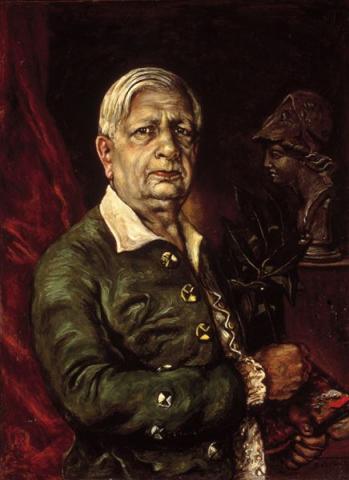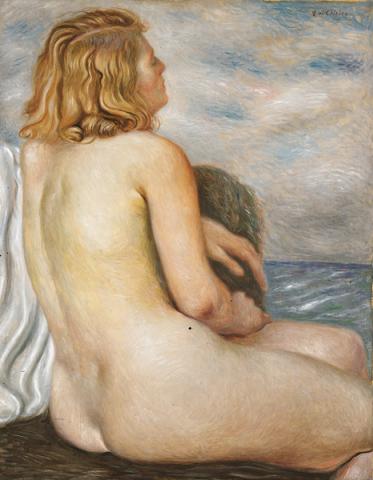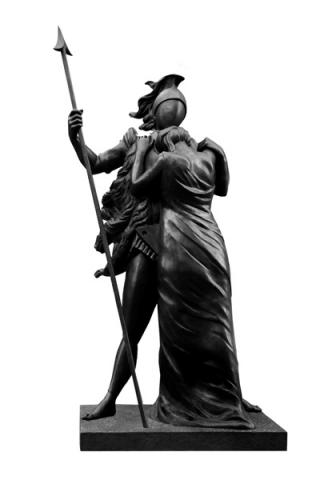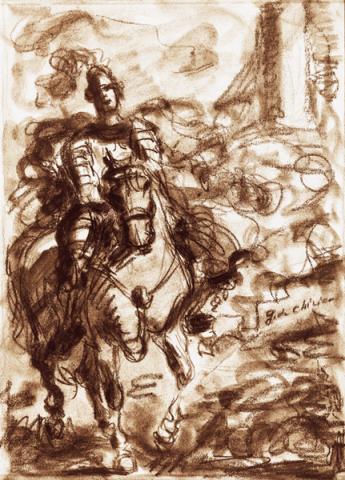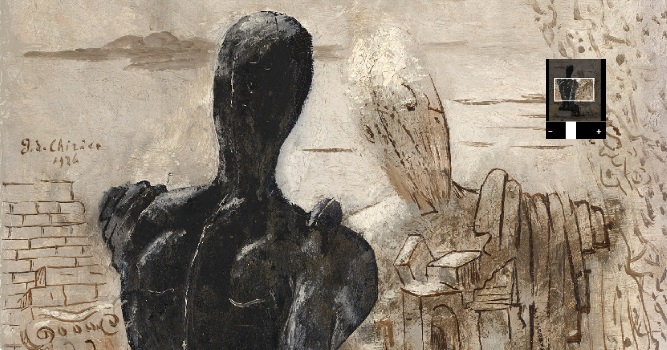The Bilotti Chapel of Gianni Mercurio
The Bilotti Chapel
The Bilotti Chapel, say the captions under the project model on display in the Warhol Museum in Pittsburgh. Carlo Bilotti intended that the building, which he commissioned in 1983, should be constructed in Florida. Warhol suggested, however, that it should be built on the summit of one of the steep and isolated hills that characterise the geography of the city of Cosenza.
After Warhol’s death, the project was abandoned, but the idea of art as a place of meditation stayed alive for Bilotti. So much so the recently he commissioned Damien Hirst, David Salle e Jenny Saville to create works that would give form to his quest for transcendence. “I don’t believe that these works would be right for a chapel” Bilotti says, “partly because when you talk about a chapel, particularly to italians, they think of a religious place”. Changing direction from the project that was entrusted to Warhol in the early eighties, Bilotti now aims for a place that is meditative in the sense of spacious, a he himself says “a place that can put you in a good or bad mood”.
In the caves of Lascaux, in the Dordogne, in France, the oldest pictures known to us have been found. They date from seventeen thousand years ago and address the theme of the sacred nature of death. From this we can see that as soon as art was invented it was an invitation to silence and to reflection. In the collective imagination this type of silence has its appointed places: a chapel, meaning here an intimate, but not necessarily religious place, is one of these. Among the most famous chapels of modern times Henry Matisse’s Rosario Chapel, created at Vence, outside Nice in 1949, and the Rothko Chapel, constructed in Houston in 1971 following a design by Philip Johnson by Mark Rothko, are outstanding. For his chapel, Matisse used a process of simplification of the main decorations through paper cut outs, mosaics, stained glass and sculpture. Johnson and Rothko’s choices were much more radical. Their work referenced the Pantheon in Rome, although naturally on a somewhat reduced scale. They envisaged an interreligious chapel, a place of meditation on existence on earth and beyond, open to people of every creed. The chapel was illuminated from the centre by natural light falling from on high, recreating the atmosphere and shadowy spaces of early christian churches, in which the thick walls, with gaps allowing only thin rays of light to pass and occasionally permitting a patch of sky to be glimpsed, hold in spirit and thought, separating them from nature.
As a personal friend of such artists as Giorgio De Chirico, Salvador Dalí, Andy Warhol, Roy Lichtenstein, Niki de Saint-Phalle, Larry Rivers, Mimmo Rotella, Piero Dorazio, Erich Fischl, and Julian Schnabel, Bilotti is interested in the era in which he has lived and in the works of his contemporaries. For his chapel, he chose Warhol and he engaged the New York architect Lawrence Harman, who in turn applied to one of the most ascetic architects of history, Louis Kahn.
In 1983 the four side chapels of the Bilotti Chapel were designed to reprise in their layout one of Warhol’s Flower paintings. The walls would have been covered with large canvases involving floral details and medieval manuscripts. Warhol’s conception is obviously different from Rothko’s, who in turn is some way from that of Matisse. Warhol sees in nature and in light a moment of joy in which we draw close to divinity, and has a humanistic conception of life: if Rothko was thinking about the Pantheon in Rome, Warhol had in mind the Baptistery in Florence. Twenty years later, when the idea of the chapel had been abandoned, Bilotti decided to bring to life a project involving Damien Hirst, David Salle and Jenny Saville, asking them to imagine a place more mental than physical, a space with which their works could interact. Bilotti is a collector. Collecting objects is a way of approaching life, of developing a relationship with time which nullifies it and deprives it of its value through a collection of human testimonies sufficient to challenge eternity: men die, works of art do not. A collector has a positive vision of existence: starting from the supposition that art has a value that will be protected through time, he considers his own collection as a record which, together with the memory of the work keeps alive also the memory of whoever has saved it. Too often the collector is confused with the speculator in art, but the true collector does not allow the works that he has collected to be dispersed. He sees his personal museum as an indivisible unit. He may substitute, add or subtract works, but this is always done with a view to keeping compact that which he considers the main body of the art. The collector’s vision is subjective. His view of the uniqueness of his own collection, makes him feels the breath of History through the works he has collected. Bilotti pushes further, not content merely to choose art. He wants to incite in the artists a new creative spark, which will interact with their own. It was to supply this participative force, that he commissioned works from Hurst, Salle and Saville, suggested a common theme to them all. Naturally the three artists reacted in different ways, maintaining their own autonomy and individuality. Damien Hirst takes on the theme of the Four Evangelists with an intellectual-symbolist (neoconceptual) approach, David Salle refers to the frescoes of the Sistine Chapel, transposing them into a modern key and Jenny Saville identifies in the theme of illness that od expiation, a reflection on human suffering, regardless of its nature.
Hirst makes explicit reference to the Sacred Scripture. His four vertical paintings show, when seen together, a tension which recalls the spirit of Yves Klein and which is driven by the details which in the individual parts of the work are closed in like a secret waiting to be revealed. The most important of these details recalls the first page of the different gospels: Hirst places the opening words on the vertical axes of the frame. A pen is placed in the middle of ever panel, to indicate that there are many sacred pages still waiting to be written. Hirst describes an unknown galaxy onto which with pins he fixes butterflies: their immobility recalls the death which comes to beauty and strikes it down: the butterfly which maintains its beauty even in death is a metaphor for immortality. And again, at the bottom left of every single painting, we find a crucifix, two razor blades, two pills, all objects which evoke the obsession with death and corruption.
Salle takes up Bilotti’s challenge by citing the Sistine Chapel. He shows the themes of the creation, of the flood and the last judgement. He uses a Michelangelo-esque departure as a background, superimposing contemporary images which refer to dramatic events such the tsunami, the Israelo-palestine war, the flooding of New Orleans...
In this way he juxtaposes the truth of the Holy Scriptures with the truth of reporters. It is not the first time that Salle has appropriated fragments of paintings and statues from the past; but contrary to his previous work, in these pieces he allows the Michaelangeloesque quotation, although decontextualised, to keep its own original sense. Salle’s work sees in the gathering up of chaos a form of dialectic: their mutual presence involves a dialogue between form and languages, a dialogue between different people, a dialogue between the canvases which make up the diptych, a dialogue between the small autonomous canvases inserted into the representation of the central body of the painting, the dialogue between Salle himself and the human universe which lies around him and with which he has a relationship. The concept is that the individual parts, although autonomous, legitimise each other as part of the total function.
If Salle’s works carry the gaze on high and Hirst’s carry it to the height of man, Jenny Saville’s three canvases bring it down to earth. For her, the body is a territory marked by pain. Rosetta, a young girl blind from birth, a man in a hospital bed and a girl with bloody hands abandoned on a bed, are intended as a study for the theme of redemption. The suffering represented by Saville is a profoundly human suffering, but also a way of moving towards a higher form of spirituality. The same spirituality with which Carlo Bilotti, with a secular attitude, observes.
Gianni Mercurio
Curatore della mostra


























